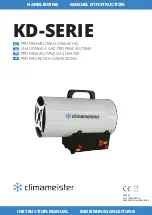
9
• The burner is approved for use with fuel oil not heavier than No. 2.
2. An approved, separately fused circuit with disconnect switch should be
available for the oil burner. Using Figure 14 and 15, the wiring diagram
below as a guide:
• Route the 120 volt incoming line in the dual bulb thermostat,
mounted on the side of the heater.
• Bring the factory wiring from the high limit /eco and thermostat into
the oil burner junction box.
• Install field and factory wiring as shown in the wiring diagrams, figs. 14.
A schematic diagram is also shown for convenience when servicing.
• Ground the heater in accordance with the NEC code to guard against
electrical shock from the heater or water system.
3. All burners have "intermittent ignition" as defined by UL (ignition is on
during the time the burner is on and off when the burner is off).
4. Do not "test fire" the heater to complete the oil burner certificate until
the tank is filled with water, see the oil burner manual.
The certificate and this manual must be left with the user for future reference.
TABLE 8. OIL PUMP & NOZZLE SPECIFICATIONS
Fitting Rate
(GPH)
Oil Burner
Oil Burner
Non
Pump
Oil Burner
Nozzle
Heater
State State Non-Setting
Nozzle
Rating
Model
Burner Burner
PSIG
Spec.
(GPH)
GPO 86 -199
1.42
1.1
110
1.35 x 80°B
1.35
GPO 86-245
1.75
1.5
100
1.75 x 80°B
1.75
GPO 84-315/315A 2.25
2.0
100
2.25 x 80°B
2.25
GPO 75-385/385A 2.75
2.5
100
2.75 x 80°B
2.75
GPO 75-455/455A 3.25
3.0
100
3.25 x 80°B
3.25
GPO 69-700/700A 5.00
4.5
100
5.00 x 80°B
5.00
FUEL PUMP
GENERAL
All heaters are shipped with the pump pressure set at 100 psig except the
GPO 86-199 which is set at 110 psig.
All oil pumps are fitted for installation on single fuel line systems. The pump
may be adapted for two line service by using the by-pass Plug and pump
manufacturer's instructions packed with the burner.
The single-stage pumps are for single-pipe or two-pipe installations, either
lift or gravity feed. On gravity feed installations the inlet pressure is not to
exceed 3 psig
.
On one pipe lift installations the lift is not to exceed 8 ft.
The two-stage pumps are for two-pipe lift installations where the inlet
vacuum does not exceed 20" hg. vacuum.
AIR BLEED PROCEDURE (Refer to oil burner manual).
OPERATION
GENERAL
Never operate the heater unless the tank is filled with water and a
temperature and pressure relief valve is installed.
FILLING
1. Oil burner electrical disconnect switch should be in the "OFF position
2. Close the heater drain valve.
3. Open a nearby hot water faucet to allow the air in the system to
escape.
4. Fully open the cold water inlet valve, filling the heater and piping.
5. Close the hot water faucet as water starts to flow from the opening,
Leave the cold water inlet valve fully open. The heater is now ready to
start-up if being placed in operation for the first time.
START-UP
Factory Start-Up is required for activating warranty and assuring maximum
operating performance. Contact your local sales representative or
Authorized Start-Up Agent to arrange a FREE Certified Start-Up.
The following checks should be made by the installer when the heater is
placed into operation for the first time:
1. Check all factory and field made water, oil and electrical connections
for tightness. Also check flue gas disposal provisions on top the heater.
• Repair any water and oil leaks. Tighten electrical and flue
connections as necessary.
2. Where the water heater or water heating systems includes a
circulating pump, it may need to be lubricated before operated.
The tube of lubricant supplied with the pump includes directions
for use.
• Field installed circulating pumps should be all bronze construction.
Be sure the oil burner, related piping, valves and controls are in place,
adjusted and ready for operation before turning on the electricity.
3. Adjust the heater mounted control as follows:
FIGURE 14.
FIGURE 15.
SOLENOID PROVIDED ON GPO 75-385(A), GPO 75-455(A), GPO 69-700(A)










































